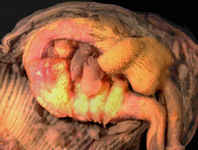Abstract
A new catfish, Silurus tomodai, is described based on 37 specimens; 132-514 mm > 139-514 mm [132–514 mm standard length (SL)] collected from streams of Mie, Aichi, Gifu, Shizuoka and Nagano prefectures of central Honshu Island, Japan. Although S. tomodai is closely related to S. lithophilus (Tomoda, 1961) based on partial mitochondrial DNA sequences, the former can be distinguished from the latter by the position of dorsal fin (predorsal-fin length 28.5–32.1% vs. 30.1–33.7% SL), a shorter head (18.5–21.2% vs. 19.5–22.2% SL) that is more broadly rounded in ventral view, a more slender body (depth at 10th anal-fin ray 12.9–18.3% vs. 15.7–18.8% SL, and 86.8–100.3% vs. 97.2–109.7% of body depth at anal-fin origin), longer mandibular barbel [20.4–47.7% vs. 10.7–35.3% of head length (HL)], shorter anal-fin rays (10th anal-fin ray length 32.2–38.3% vs. 37.3–45.3% HL), eye slightly protruding laterally beyond profile in dorsal view, and the shape of medial depression on anterior face of mesethmoid (deep and narrow vs. shallow and wide). Silurus tomodai differs from S. asotus, a species widely distributed in Japan including central Honshu Island, in the shape of vomerine-tooth band (typically separated into two distinct lenticular patches vs. continuous), the shape and size of teeth (small and slightly recurved vs. relatively large and recurved), snout length (34.7–38.9% vs. 33.0–36.5% HL), the length of lower jaw (110–124% vs. 124–138% of snout length), interorbital width (53.0–61.3% vs. 46.3–52.8% HL), eye location (vertical through anterior margin of pupil usually posterior vs. anterior terminus of lips), inter-mandibular barbel width (24.7–32.5% vs. 21.7–26.7% HL), vertebral count (62–65 vs. 58–63), pigmentation on underside of head (usually mottled with dark pigmentation vs. uniformly white, rarely dark with pale band along posteroventral margin of lower jaw) and eggs yellow (vs. light green).
References
Aoyama, J., Watanabe, S., Ishikawa, S., Nishida, M. & Tsukamoto, K. (2000) Are morphological characters distinctive enough to discriminate between two species of freshwater eels, Anguilla celebesensis and A. interioris? Ichthyological Research, 47, 157–161.
https://doi.org/10.1007/BF02684236Bornbusch, A.H. (1991) Monophyly of the catfish family Siluridae (Teleostei: Siluriformes), with a critique of previous hypotheses of the family's relationships. Zoological Journal of the Linnean Society, 101, 105–120.
https://doi.org/10.1111/j.1096-3642.1991.tb00888.xBritz, R. & Win, T. (2010) Redescription of Silurus burmanensis Thant 1967: a Silurus not a Pterocryptis (Teleostei: Siluriformes: Siluridae). Zootaxa, 2647, 61–68.
Chen, H.-L. (1977) A review of the Chinese Siluridae. Acta Hydrobiologica Sinica, 6, 197–218, pls. 1–2.
Ferraris, C.J. Jr. (2007) Checklist of catfishes, recent and fossil (Osteichthyes: Siluriformes), and catalogue of siluriform primary types. Zootaxa, 1418 (1), 1–628.
https://doi.org/10.11646/zootaxa.1418.1.1Fricke, R. & Eschmeyer, W.N. (2016) A guide to fish collections in the catalog of fishes. Online Version. Updated 31 January 2017. Available from: http://researcharchive.calacademy.org/research/ichthyology/catalog/collections.asp. (accessed 17 February 2016)
Fujita, T. (2015) Namazu. In: Hosoya, K. (Ed.), Freshwater Fishes of Japan. Yama-Kei, Tokyo, pp. 206–207.
Hu, X.-Y., Lan, J.-H. & Zhang, C.-G. (2004) A new species of the genus Duanensis (Siluriformes, Siluridae) from Guangxi, China. Acta Zootaxonomica Sinica, 29, 586–590.
Hubbs, C.L. & Lagler, K.F. (1958) Fishes of the Great Lakes Region. Cranbrook Institute of Science Bulletin 26. Bloomfield Hills, Michigan, 213 pp.
Kawase, S. & Hosoya, K. (2010) Biwia yodoensis a new species from the Lake Biwa/Yodo River basin, Japan (Teleostei: Cyprinidae). Ichthyological Exploration of Freshwaters, 21, 1–7.
Kobayakawa, M. (1989) Systematic revision of the catfish genus Silurus, with description of a new species from Thailand and Burma. Japanese Journal of Ichthyology, 36, 155–186.
https://doi.org/10.1007/BF02914319Matsuzawa, Y. & Senou, H. (2008) Nihon-no-gairaigyo-gaido (Alien Fishes of Japan). Bun-ichi, Tokyo, 157 pp.
Nakagawa, H., Seki, S., Ishikawa, T. & Watanabe, K. (2016) Genetic population structure of the Japanese torrent catfish Liobagrus reinii (Amblycipitidae) inferred from mitochondrial cytochrome b variations. Ichthyological Research, 63, 333–346.
https://doi.org/10.1007/s10228-015-0503-6Nguyen, V.H., Vu, T.H.N. & Nguyen, T.D.P. (2015) Three fish species of the genus Silurus Linnaeus, 1758, (Siluridae, Siluriformes) newly discovered in northern Vietnam. Journal of Science and Development, 13, 65–74.
Palumbi, S., Martin, A., Romano, S., McMillam, W.O., Stice, L. & Grabowski, G. (1991) The Simple Tools Guide to PCR. Department of Zoology and Kewalo Marine Laboratory, University of Hawaii, Honolulu, 47 pp.
Tabata, R., Kakioka, R., Tominaga, K., Komiya, T. & Watanabe, K. (2016) Phylogeny and historical demography of endemic fishes in Lake Biwa: the ancient lake as a promoter of evolution and diversification of freshwater fishes in western Japan. Ecology and Evolution, 6, 2601–2623.
https://doi.org/10.1002/ece3.2070Tamura, K., Stecher, G., Peterson, D., Filipski, A. & Kumar, S. (2013) MEGA 6: molecular evolutionary genetic analysis version 6.0. Molecular Biology and Evolution, 30, 2725–2729.
https://doi.org/10.1093/molbev/mst197Tominaga, K., Nakajima, J. & Watanabe, K. (2016) Cryptic divergence and phylogeography of the pike gudgeon Pseudogobio esocinus (Teleostei: Cyprinidae): a comprehensive case of freshwater phylogeography in Japan. Ichthyological Research, 63, 79–93.
https://doi.org/10.1007/s10228-015-0478-3Tomoda, Y. (1961) Two new catfishes of the genus Parasilurus found in Lake Biwa-ko. Memoirs of the College of Science, Kyoto University, Series B, Biology, 28, 347–354.
Tomoda, Y. (1962) Studies of the fishes of Lake Biwa-ko. I. Japanese Journal of Ichthyology, 8, 126–146.
Tomoda, Y. (1978) Biwako-to-namazu (Lake Biwa and Catfish). Choubunsha, Tokyo, 326 pp.
Watanabe, K., Kawase, S., Mukai, T., Kakioka, R., Miyazaki, J.-I. & Hosoya, K. (2010) Population divergence of Biwia zezera (Cyprinidae: Gobioninae) and the discovery of a cryptic species, based on mitochondrial and nuclear DNA sequence analyses. Zoological Science, 27, 647–655.
https://doi.org/10.2108/zsj.27.647

